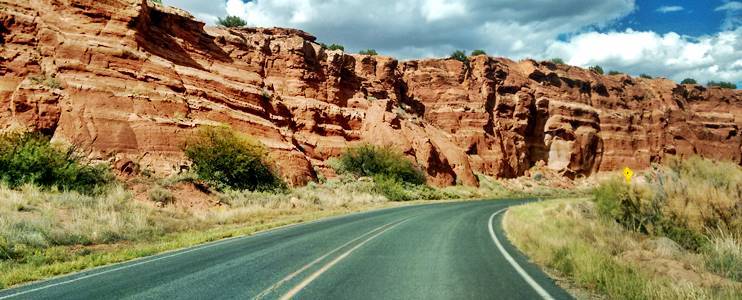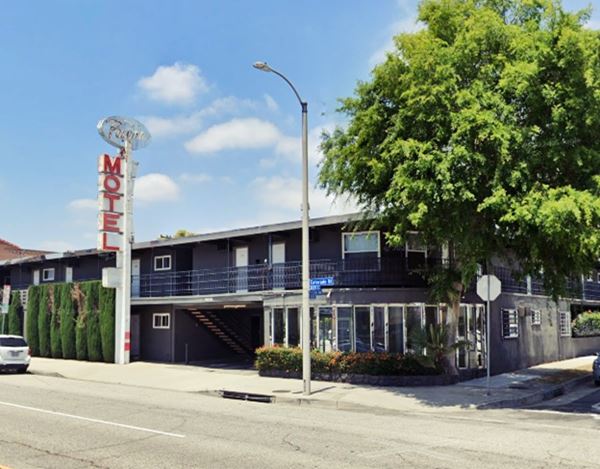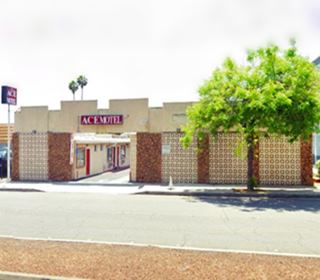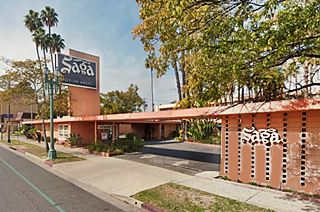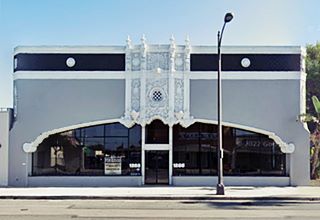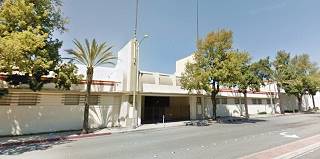About Pasadena California
Facts, Trivia and useful information
Elevation: 863 ft (263 m). Population 137,122 (2010).
Time zone: Pacific (MST): UTC minus 8 hours. Summer (DST) PDT (UTC-7).
Pasadena is a city located Route 66 in Los Angeles County in southern California on the San Gabriel Mountains' foothills; it is part of the Los Angeles metropolitan area. (Map of Pasadena).
Antique early 1960s postcard view of Route 66 in Pasadena looking east from Los Robles St. and E. Colorado Blvd. (Route 66)
The Downtown Pasadena: Colorado Blvd. nowadays
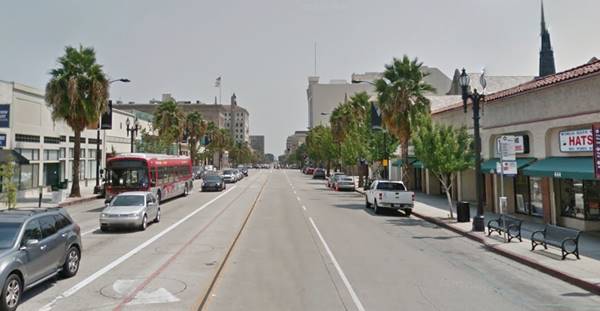
Click image for Street View
The history of Pasadena
Paleoindians settled in the San Gabriel Mountains' foothills some ten thousand years ago and their descent, the "Tongva" natives were encountered by the Spanish when they explored the area in the 1600s. They called them "Gabrieleños" or "Gabrielinos", after the mountains.
The San Gabriel Mission was established close to the mountains in 1771 and owned a vast tract of land which was nationalized by the Mexican government in the 1830s (Mexico had become independent from Spain in 1821).
The Rancho del Rincon de San Pascual (Saint Paschal's corner Ranch) covered 13,694 acres (5.540 ha) and was granted to Juan Marine in 1834; after his death to José Pérez and Enrique Sepúlveda received it (1839), and after their death, Manuel Garfias claimed it and got the land grant in 1843 from the Mexican Governor Micheltorena.
Garfias sold part of his interest to Benjamin Wilson in 1852 (he was the grandfather of WWII General George S. Patton, Jr.). A project to build a large adobe ended up bankrupting Garfias who sold out to Wilson in 1858.
In the meantime Mexico was defeated by the US in the 1846-48 war and had to cede territory to the victor; this included California, which became a state of the US in 1850.
In 1860 Wilson sold half of his holding in the Rancho to John S. Griffin. And when a group of investors from Indianapolis, Indiana, scouted the area for a more balmy place to live (1873), they bought most of the property from Griffin.
The land which ran between Arroyo Seco River, and what is now Fair Oaks Ave. became the Indiana Colony, after the state of the new owners and it incorporated in 1874. The land to the east was part of Wilson's Lake Vineyard. Both merged into Pasadena ten years later. Incorporating as a city in 1886.
The Name, Pasadena
The opening of the post office in 1875 required a formal name. And Pasadena was chosen.
Calvin Fletcher, one of the town's stockholders knew that Manuel Garfías had built is house there because it was "the key to the Ranch", its entrance point, T. B. Elliott, president of the Colony then asked a friend of his, a missionary among the Chippewa Indians to translate it into an Indian verison. This led to "Weoauqn Pa sa de na" (Crown of the Valley) which was shortened to "Pasadena".
The Los Angeles and San Gabriel Valley Railroad built a line along the Arroyo Seco and linked Pasadena with L.A. It later became the Santa Fe Railroad in 1887, which had reached the area linking it with the main line, all the way east to Saint Louis.
The Pacific Electric Railway "Red Car" tramway also extended a line along the Arroyo Seco into Pasadena.
The town's good weather drew many wealthy people to it, and on the western part of Pasadena are the remains of their 1890's mansions, along Orange Grove Ave., Millionaire's Row.
National Old Trails Highway (N.O.T.) in Pasadena
The use of the automobile had grown greatly in the early 1900s, and the National Old Trails (N.O.T.) Association was formed to promote the construction of a highway linking New York with L.A. This road ran along Colorado St. and Foothill Blvd. eastwards towards San Bernardino, and south, through South Pasadena, into Los Angeles.
Route 66 in Pasadena
US highway 66 (Route 66) was created in 1926 aligned along the N.O.T. highway in Pasadena. It would go through many changes in its alignment over the course of the years which we describe below: (US 66 in Pasadena).
The 1939 "Guide to the Golden State" written by the WPA gave a complete description of Pasadena, and pointed out that: "... The center of the small business district is the intersection of Colorado Street and Fair Oak Avenue. Here the streets are lined with smart shops, lighted at night with a restrained display of neon lights....", a classic Route 66 Main Street image from the pre-War days.
Just after the end of World War II, Jack DeVere Rittenhouse drove the whole of Route 66 collecting information for his famous 1946 work, "A Guide Book to Highway 66". He mentioned a list of the towns along Route 66 and dedicates the following to Pasadena : "... Now you pass through SIERRA MADRE at 353 mi. and soon enter PASADENA at 359 mi. Pasadena is famous for its Rose Bowl, Tournament of Roses and the Pasadena Playhouse.".
The Los Angeles freeway system was born with the Arroyo Seco Parkway in 1940, between L.A. and Pasadena. Route 66 was aligned along it. Soon more freeways and the Interstate highways would cover the region and by 1964 Route 66 would begin to be replaced across San Gabriel Valley.
Where to Lodge in Pasadena
Lodging in the City of Pasadena
> > Book your in Pasadena.
More Lodging near Pasadena along Route 66
Motels and Hotels close to Pasadena, California
Heading West... Hotels & Motels in California...
- 11 miles Los Angeles
- 15 miles Hollywood
- 27 miles Santa Monica
Heading East.... In California
- 43 miles Fontana
- 47 miles Rialto
- 52 miles San Bernardino
- 57 miles Cajon Junction
- 73 miles Hesperia
- 78 miles Victorville
- 91 miles Helendale
- 113 miles Barstow
- 267 miles Needles
Book your hotel in Pasadena
Booking.com>> Check out the RV campground near Pasadena, in Pomona
Weather in Pasadena

The climate in Pasadena is a Hot Summer Mediterranean one. Rather dry and hot in summer but cool and wet during winter (which can bring heavy rains), the January night temperature often falls just below freezing. Spring is warm and Summers are hot, with high temperatures extending into October which brings a short Fall, cool and hot, erratic.
Pasadena has some 290 sunny days each year and during fall (autumn) strong dry winds blow from the desert (Santa Ana winds) drying out the area and increasing the risk of wildfires in the foothills.
The summer average high is 89.4°F (31.9°C) and the average low is 61.1°F (16.2°C).
During winter the average high is (Jan) 67.8°F (19.9°C) and the average low is 44.3°F (6.8°C) in winter, the peaks of the San Gabriel Mountains receive snow, and may very rarely fall in Pasadena. You may experience some frost during winter (Dec. to Mar.)
Rainfall averages 21 in. per year (535 mm), most rain falls during the period from November to April, the rest of the year less than 0.5 in. falls monthly. There are 43.8 rainy days yearly.
Tornado risk
Pasadena is located very close to the Pacific Ocean and well beyond the Rocky Montains (which are the western limit for tornados) so there is no risk of tornados in the city.
Tornado Risk: read more about Tornado Risk along Route66.
Getting to Pasadena
You can reach Pasadena along old Route 66 or via Interstate 10, 15, 215, 610 or state higways 110 and 134. All of them are freeways.
Map of Route 66 through Pasadena into Los Angeles
Static Map showing Route 66 alignment through Pasadena into Los Angeles CA - CLICK ON MAP TO ENLARGE
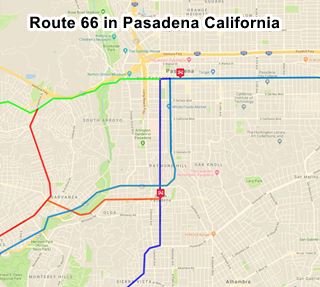
Click on Map to Enlarge
Color Key to the Map of Route 66 into LA from Pasadena.
This is the map of Route 66 through Pasadena and this is the map's color key:
Blue: The 1926 to 1931 alignment of Route 66 through Pasadena and South Pasadena.
Orange: The 1931 -34 alignment along Mission St. and Pasadena Ave. from South Pasadena.
Green line: The 1935 alignment through Eagle Rock.
Red: The 1936 -39 alignment along N Figueroa St. - later named US 66 Alt.
Pale Blue: the 1940 - 1964 Route 66 through Pasadena and south via the Arroyo Seco Parkway.
Black: the earlier, 1926 to 1935 Route 66 in Sierra Madre, east of Pasadena.
You can always check out our Route 66 Map of California, with the complete alignment and all the towns.
A Map showing Los Angeles
Route 66's alignment in California: the Historic Route 66 into Pasadena

Route 66 across California
U.S. Route 66 does not have any Byway or Historic designation in California despite the survival of long sections of original roadbed between Needles and Santa Monica.
Click Here for an overview of Route 66 across the state of California.
Below you will find detailed information on Old Route 66 in Pasadena.
Route 66 sights in Pasadena, California
What to Do and See in town
Pasadena and its Route 66 attractions
Crown City
Besides its Route 66 attractions, the town is also home to the California Institute of Technology (Caltech) ad the Jet Propulsion Laboratory. Mount Wilson Observatory was established nearby in 1904.
Pasadena has plenty of landmarks and Route 66 attractions:
Motels such as the: Pasada Motel, the Vagabond Inn - former Imperial 400,
the Astro Motel -Now Knights Inn, the La Casa Inn - now Swiss Lodge, the
Saga Motor Hotel, the El Rancho Motel, the Ace-Hi Motel,
the Arroyo Sojourn Motor Inn or the Hiway Host Motel.
Historic landmarks such as the Bekins Storage Co. Roof Sign, the Colorado Street Bridge,
Arroyo Seco Parkway the Howard Motor Company Building or
the Foothill Boulevard Milestone (Mile 11).
The Millionaire's Row Mansions with Gamble House and Wrigley's Mansion and
the Art Deco buildings: Draper's Studio of Modes and the Pasadena Winter Garden Skating Rink, among others.
Pasadena City tour
Begin your tour at the eastern side of town, on Route 66 (E. Colorado Boulevard and Michillinda St., just past the Former Eaton's Hotel in Arcadia), and drive west along E. Colorado Blvd.
Colorado Boulevard
Known as Colorado Street until 1958 it runs from eastwards from Orange Grove Blvd. in Old Town Pasadena up to Michillinda Avenue wher it becomes Colorado St. in Arcadia.
In 1929 it was widened by cutting back the buildings on each side of the road by 14 ft. eet (4.3 m) on each side.
As the road begins to curve towards the SW, on your right, is the El Rancho Motel:
El Rancho Motel
3853 E Colorado St.
You can compare this Old postcard of the El Rancho Motel with its current street view below. It is still operating as a motel on old Route 66 in Eastern Pasdena:
The El Rancho Motel nowadays
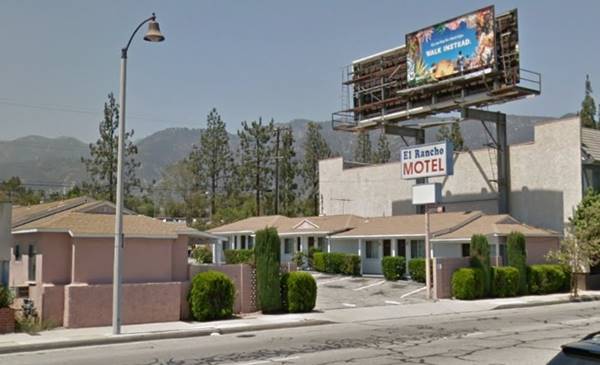
Click image for Street View
After 0.4 mi., on your right is the Pasada Motel:
The Pasada Motel
3625 E Colorado Blvd.
One of the few remaining vintage Route 66 motels in town. The neon sign is a survivor from the 1950s. By the way, "Pasada" a shortened form of "Pasadena", in Spanish means: "to pass by something".
Keep west, and after 0.2 mi., on your left, is the Hiway Host Motel:
Hiway Host Motel
3474 E Colorado Blvd.
You can Book a Room in the Hiway Host Motel
It's eye-catching sign is worth a photo. See its street view.
The Route 66 sign of the Hiway Host Motel
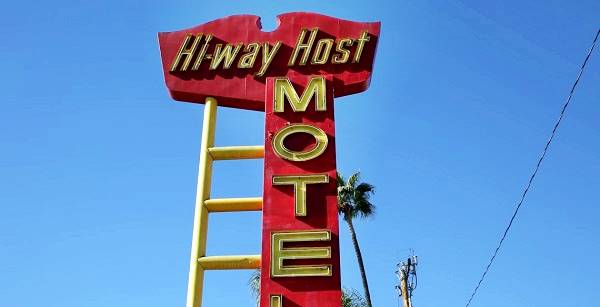
Don't miss the U.S. Post Office building to your left (0.5 miles - 3016 E Colorado Blvd.) as you drive west and 0.2 mi. ahead also on your left is the Ace Hi Motel:
Ace-Hi Motel
2870 E Colorado St.
The facade has changed a bit but the layot is untouched: a main entrance portico (now with more decorations on its upper part). The sign is still at the western end of the property.
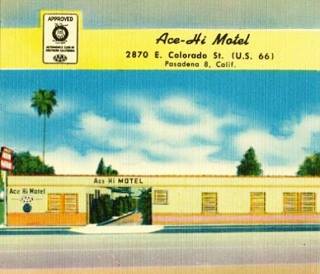
A vintage postcard of the Hi-Ace Motel in Pasadena.
www.66postcards.com
On the next block, on your left are two classic Route 66 motels: The Astro and the La Casa Inn:
The old Astro Motel - Now Knights Inn
2818 E Colorado Blvd.
This motel has a typical "Googie Architecture" (pronounced "gu:gi), a theme popular in the 1960s during the Atomic and Space ages. The buildings featured futuristic geometric shapes with symbolic motion designs and areodynamic themes like this wing-shaped canopy:
Check its Street View.
The "Space Age" design of the former Astro Motel's canopy
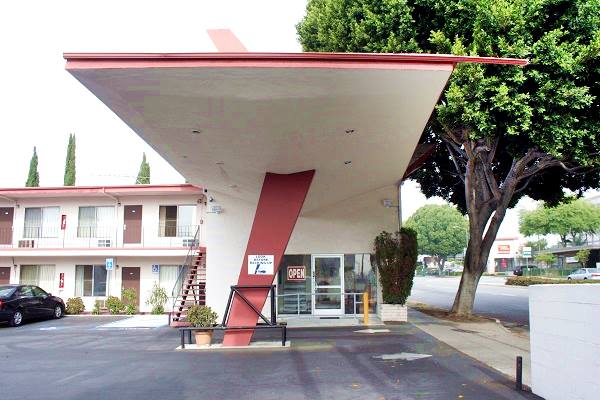
The motel chain opened in 1964 as the and was part of a chain that spanned California, Utah and Arizona and even reached Kansas.
There are several on Route 66 are: the Barstow Astro and the Winslow Arizona Astro, another one in Kingman and one in San Bernardino
And right next to it, is the Swiss Lodge:
Former La Casa Inn - now Swiss Lodge
2800 E Colorado Blvd.
It was at one time a Hyatt Chalet built in 1961. This design dates back to 1960 when Hyatt planned to build some 200 similar motels by 1966. They became the Hyatt Lodges, a new division within the company. This one has very "sixtyish" colored glass panes on the facade. Notice the steep gabled roof. Compare it to some of the extant motels of this chain, also on Route 66: the Needles Inn (Needles CA) and the Hyatt Chalet Motel in Albuquerque New Mexico.
You can Book a Room in the Swiss Lodge Motel
The Swiss Lodge Motel today, formerly the La Casa Inn:
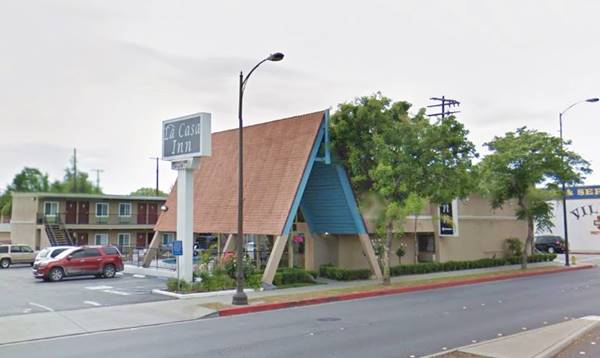
Click image for Street View
Continue west for 1 mile, and to your left is a great neon sign: Cameron's Seafood:
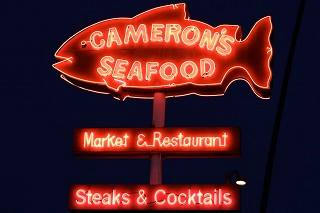
The fish-shaped neon sign at Cameron's
Cameron's Seafood Sign
1978 E Colorado Blvd.
This restaurant opened in 1984 and offers great seafood dishes. Street view of the sign.
Continue westbound and to your right, after 0.1 miles is an Art Deco Building from the 1920s, Draper's Studio of Modes:
Draper's Studio of Modes Art Deco Building
1855 E Colorado Blvd. On the NW corner of Colorado Blvd. and N. Parkwood Ave.
Draper's Studio of Modes was founded by Virgina Draper in 1927 and is now a nationwide chain of retail shops.
Her original store in Pasadena is shown can be seen in this 1951 postcard. Described as "Southern California's smartest apparel shop".
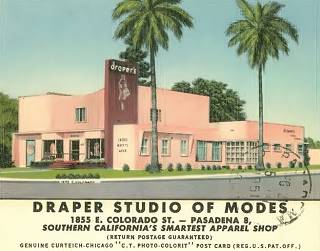
Vintage Postcard from 1951www.66postcards.com
It is a good example of art-deco style applied to a small commercial building. Art Deco flourished between both World Wars (1914 - 1940). It was a symbol of wealth, luxury and elegance that adopted symmetry, rich colors and bold rectilinear geometric shapes to exalt the technological progress of the early twentieth century. These shapes are clearly seen in the building.
The Draper's Studio Building nowadays (it is the Rose City Dental Arts)
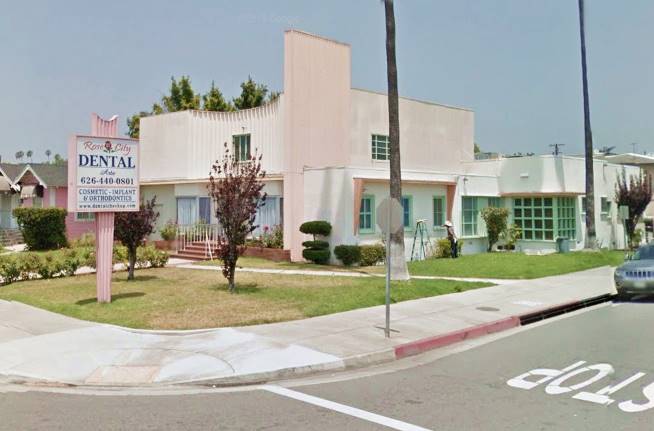
Click image for Street View.
After 0.3 mi., on your right is a classic, The Saga Motor Hotel:
Saga Motor Hotel
1633 E. Colorado Blvd.
It was "Pasdena's most convenient downtown Motor Hotel, 71 Luxurious Rooms... Color Television in all rooms... The Rose Parade Route."

Vintage poscard of the Saga Motel www.hippostcard.com
0.4 mile west, on your left, on the sidewalk in front of the McDonald's is a historic milestone marker:
Foothill Boulevard Milestone (Mile 11)
Listed in the National Register of Historic Places
1308 East Colorado Blvd.
On the south side of the road on the SW corner of E. Colorado Blvd. and Holliston Ave. is a concrete marker, 3.5 ft. tall (107 cm) stuck in the grass next to the sidewalk. It is a milepost of the Bancroft system devised by Albert Bancroft and implemented in 1892 and it marked the distance in miles from the Los Angeles County Courthouse, it also indicated the block numbers (220 and 222) as subunits of the mile. It was placed there in 1902 and the system was abandoned in 1908. This is the only remaining markker on the Foothill Blvd. Route
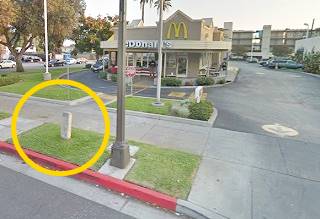
Present view of the Historic milestone in Pasadena. Google
Click image for Street View
And halfway down the block, on the north side of Colorado Blvd., a classic Route 66 auto dealership: Howard Motor Company:
Howard Motor Company Building
Listed in the National Register of Historic Places
1285 East Colorado Blvd
The building, to your right was built in 1927 on the newly created Route 66 in a spot favoured by many local automobile dealers. It was built in a heavily ornate style known as "Churrigueresque".
This baroque style came from the 17th century Spain and was an eye-catcher for the dealership: an elliptical arch spans the facade and there is an ornamental frieze in the middle. The corners are chamfered and decorated too. Later it was the Noll Auto Company (see vintage 50's postcard below):
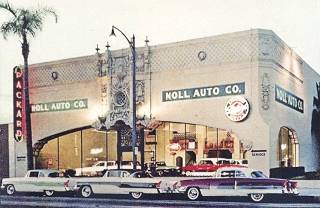
Vintage poscard of the Noll Auto Co. www.ebay.com
Head west for 0.1 mile and on the NW corner, to your right is the Vagabond Inn Motel:
Vagabond Inn - former Imperial 400
1203 E. Colorado Blvd.
This three story complex with stucco plastering,and an L-shaped layout was an Imperial 400 Motel in the 1960s.
Imperial 400 was a motel chain founded in 1959 and its buildings had a characteristic "Gull Wing" shaped roof (as shown in the postscard, but eliminated when the motel was modernized and converted into a box-lid-style roof). It went broke in the mid 1960s and sold out to new owners.
Compare it to this Imperial Motor Inn in Needles, CA (also on Route 66).
Vintage postcard view of the Imperial 400 Inn, Pasadena on Route 66
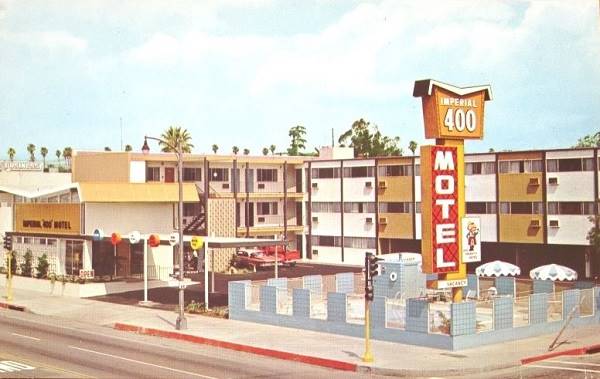
The Vagabond Inn, former Imperial 400 Motel nowadays
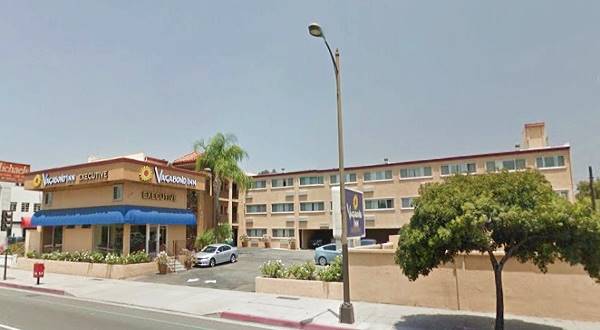
Click image for Street View
Now Drive across the downtown district of Pasadena which has changed considerably since the Classic Route 66 days (see the Pasadena Then & Now photos above). Head west for 2.1 miles (Map with directions) until reaching the historic Colorado Street Bridge, across the Arroyo Seco:
Just before the bridge: Memorial Flagpole
Located to your right, on the NE corner of Colorado Blvd. and Orange Grove Ave., is a tall flagpole with a bronze sculptured base it is a memorial to the Pasadena men who gave their live sduring World War I. It was dedicated in 1927. Street View.
Colorado Street Bridge
Listed in the National Register of Historic Places
Colorado Blvd. and Arroyo Seco
Completed in 1913, it replaced the burdensome downhill and uphill route across the steep slopes of Arroyo Seco River gully.
Arroyo Seco
Arroyo Seco (Spanish for "Dry Stream") is a temporary river that is almost 25 mi. long (40 km) running from the San Gabriel Mountains to its confluence with the Los Angeles River.
It was a natural route from Los Angeles to Pasadena and was used by the railroad, the electric trolley and the Arroyo Seco Parkway, the first freeway in LA, was built in 1940 as a parkway next to the Arroyo Seco which had been recently channeled.
The curved bridge allowed it to find support in the river bed and its concrete arches rising 150 ft. above the river bed made it the highest concrete bridge of its time.
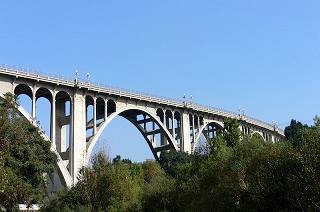
Colorado Street Bridge, Pasadena, by Mike Dillon.
The bridge had two lanes and was 28 feet wide plus plus the 5 ft. sidewalks on each side.
Colorado Street crossed it and headed into Eagle Rock from Pasadena. It also carried Route 66 until the Arroyo Seco Parkway was completed in 1940 to relieve traffic along the by then congested bridge.
Suicide Bridge
It was known as the "suicide bridge" and in 1919 the first person jumped off it. During the Great Depression many committed suicide on the bridge, and the death toll is probably more than 100.
After the Loma Prieta earthquake (1989) it closed for safety reasons and was renovated, reopening in 1993.
Drive across the Bridge and, to view the bridge from below follow Map with directions to reach West Holly St. and then Arroyo Dr. to pass below the bridge.
Vista del Arroyo
Here is a former 1920s hotel, the Vista Del Arroyo Hotel which is now the Richard H. Chambers U.S. Court of Appeals (40 Arroyo Drive, Pasadena).
End of the Tour along US 66 This completes the Route 66 drive through Pasadena, but there are more attractions in town and along the older alignment (1926) south of town: Millionaire's Row Mansions and More Route 66 attractions:
Millionaire's Row Mansions
A short 1.5 mile tour visiting two mansions in western Pasadena.
From your viewpoint under the Colorado St. Bridge, head to Orange Grove Blvd. and go north to visit the Gamble House (this is the Map with directions of the circuit).
The Gamble House
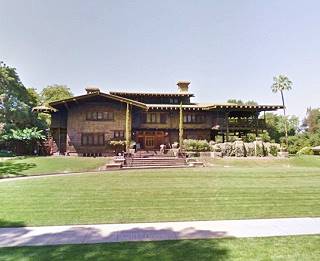
View of the The Gamble House in Pasadena. Google
Click image for Street View
Listed in the National Register of Historic Places, California Historical Landmark
4 Westmoreland Pl, Pasadena
Built in 1908 by architects Charles and Henry Geene for David Gamble, who was the son of James Gambler, of Procter & Gamble a consumer products manufacturer.
It is an outstanding example of American Arts and Crafts style architecture. It is open to the public, and a museum. Read more at Gamble House's website.
Take a short 1 mile side trip north (Map with directions) to visit the Rose Bowl:
The Rose Bowl
National Historic Landmark
1001 Rose Bowl Dr, Pasadena
It is the venue of the first post-season college football game, the Tournament of Roses Rose Bowl Game, played on New Year's Day
It opened in 1923 and was named "The Rose Bowl".
Now head south along Orange Grove all the way to Wrigley's Mansion:
Wrigley's Mansion
391 S Orange Grove Blvd.
This was the home of chewing gum tycoon, William Wrigley Jr. It was given to the city of Pasadena after the death of Mrs. Wrigley in 1958 so that it could become the permanent headquarters of the "Tournament of Roses Parade".
See a street view of the Mansion.
Tournament of Roses Parade
Held on New Year's Day every year since 1890 when it was created after the flower fetes in Nice, France, to celebrate the midwinter blooming flowers in California. It later became the "Rose Parade" with floats covered with flowers, leaves and seeds. The parade lasts for 3 hours and the floats cover 5 miles (8 km) along Colorado Boulevard.
More Route 66 attractions
This is a 1.9 mile-long route, see Map with directions.
Set out from Wrigley's Mansion and visit an iconic neon sign on a rooftop facing the 1926 alingment of Route 66 but first pass by an example of modern Public Art, (Street View), the "Fork In The Road" on S. St John Ave. and Bellefontaine St., it is a gigantic fork stuck in the ground.
Bekins Storage Co. Roof Sign
Listed in the National Register of Historic Places
511 South Fair Oaks Ave.
The sign which is 32 ft. long and 12 ft high (9.8 x 3.7 m) reads "A. American Storage Co." and is located on the rooftop of a building. It was placed there to be seen by all those driving down Fair Oaks Avenue, which was the alignment of Rote 66 from 1926 to 1940.
It marked the arrival of neon signs to Los Angeles and was built in 1926. It is the only pre-World War II sign in Pasadena.
The Bekins Storage Co. Roof Sign nowadays
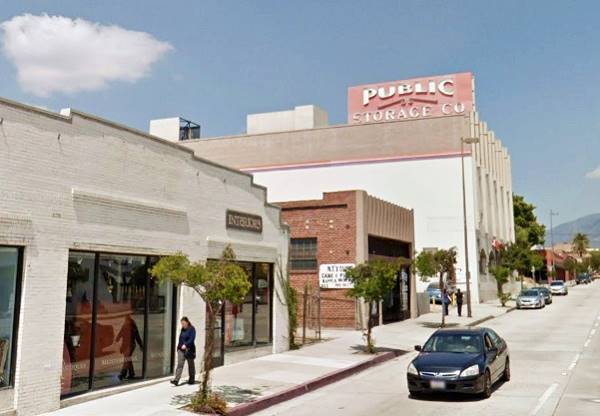
Click image for Street View
Former Arroyo Sojourn Motor Inn
400 South Arroyo Parkway
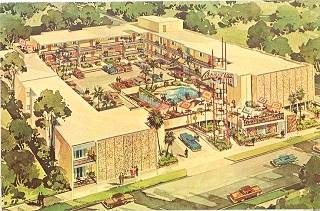
The Arroyo Sojourn Motor Inn, a 1960s postcard, www.ebay.com
Now it is the Pasadena Inn and still operating as a motel. Built in 1962 it was the Arroyo Sojourn Motor Inn. This vintage postcard announced that it had "CONFERENCE ROOMS - BANQUET - COCKTAILS - 24 HOUR RESTAURANT. All new, centrally located, minutes away from Los Angeles, Civic Center, Dodger Stadium, Rose Bowl, Santa Anita Race Track, Soundproof rooms, TV, 24-hour switchboard, refrigerated air-conditioning, heated pool.".
This is its See a street view of the motel (now Pasadena Inn).
More Route 66 sights in Pasadena
From the Inn you can either head north along South Arroyo Parkway to visit an Art Deco style skating rink or go south to drive the Arroyo Seco Parkway, or do both:
Pasadena Winter Garden Skating Rink
171 S Arroyo Pkwy.
The Pasadena Winter Garden was built in 1940 in Art Deco Style, as you can see at the main entrance: Two stylized columns flank it, with bold geometric designs. It was here that Olympic and World champion Peggy Fleming began her skating career.
The rink closed in 1966 and now is a storage facility.
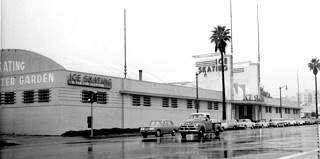
A vintage postcard of the Hi-Ace Motel in Pasadena by www.66postcards.com
Classic early 1900s Hotels & Resorts
The 1915 U.S.G.S. geologic survey along the Santa Fe Railroad mentioned that Pasadena was located in a "corner" between the San Gabriel Range, and the San Rafael Hills, which protected it from cold winds and caused more rainfall in the area, making it an attractive winter resort. This was the reason that hotels like the Raymond and Huntington built resorts offering swimming pools, horse riding and golf in the early 1900s.
Only three hotels from this era have survived: the Green Hotel (99 S Raymond Ave, built in 1893 and a co-op since 1926), The Maryland Hotel (1926) at 80 North Euclid Ave. (also an apartment complex) and the Vista Del Arroyo (mentioned above), now a U.S. court.
You can visit them in a short 1 mile route from the skating rink: See map with directions.
Alternatively you can head South along South Arroyo Parkway (1.7 miles) and reach the famous Arroyo Seco Parkway (See map with directions), which begins in Pasadena and continues through South Pasadena and Los Angeles:
Arroyo Seco Parkway
Listed in the National Register of Historic Places. National Civil Engineering Landmark. National Scenic Byway. California Historic Parkway.
The use of automobiles in LA had grown considerably in the 1920s so the city evolved and planned its layout around the car. This led to the First Freeway in the West being built in 1940.
It was a blend of "freeway" and "parkway". The freeway elements are the graded overpasses, the high-speed and limited-access road with on and off ramps. The parkway design can be seen in the landscaping and the fact that it ran through a parkland (ie.e Elysian Park).
It had 6 lanes and was designed for 27,000 automobiles per day (it now carries over 120,000 cars daily).
Several bridges and the four Figueroa Street tunnels for northbound traffic were built in Art Deco style. There are four bridges that predate the Parkway: The 1895 Santa Fe Arroyo Seco Railroad Bridge, the 1912 York Boulevard Bridge, the 1925 Avenue 26 Bridge, and the 1926 Avenue 60 Bridge.
Trucks were banned in 1943 and in 1953 it was extended to the Four-Level Interchange in downtown L.A. The following year it was renamed Pasadena Freeway.
It became the alignment of Route 66 and the old route along Colorado Blvd. and Figueroa St. became Route 66 Alt. It was this freeway carried travellers into Los Angeles during World War II and it set the example followed around the world for freeway construction.
The Arroyo Seco Parkway is California State Route 110 and runs from the interchange with U.S. 101 in downtown Los Angeles (mile post 23.69) to East Glenarm St. in Pasadena (mile post 31.89).
Tours & Itineraries
Old Route 66 in Pasadena California
From San Bernardino to Pasadena
Route 66 follows Foothill Blvd. west of San Bernardino, until Glendora and Azusa, where it has two alignments: the original 1926 one, and the later one along E. Route 66 and Aosta Ave. (see US 66 in Glendora and Azusa for full details).
Then it continues west along E. Foothill until passing Irwindale, where the road changes its name to Huntington Dr. and keeps on it all the way to Monrovia, where again there are two alignments, the 1926 one (which continues through Arcadia and Sierra Madre) and the later one (see US 66 from Monrovia to Sierra Madre for full details).
The later highway now changes its name to Colorado Pl, Colorado St. and finally, when it enters Pasadena: Colorado Blvd.
Now the detailed course of Route 66 from Pasadena to Los Angeles:
From Pasadena to Los Angeles
The first highway through the area built specially for cars, was the National Old Trails highway projected in the early 1910s to link Los Angeles and New York, it passed just south of Sierra Madre along Foothil Blvd.
The many alignments of Route 66 in Pasadena
There were several alignments of Route 66 from Pasadena into Los Angeles during the period spanning 1926 to 1940. It was only after 1940, when the Arroyo Seco Parkway became the route for US 66 into LA that these changes stopped. Contemporary maps don't clearly mark the course of US 66 into LA, but the following courses are clear:
1926 to 1931
This is shown in Blue in the Map above.
The 1927 and 1931 maps by the Automobile Club of Southern California shows the main highway (though not marked as US 66) running west along Foothill Blvd., south along San Gabriel Blvd. and then west again into Pasadena along Colorado Street. Here the road took a left and headed southwards into South Pasadena along Fair-Oaks Ave. past its downtown and south until meeting Huntington Drive, here it took a right and followed it until reaching North Broadway and followed it all the way into downtown Los Angeles. Ending on 7th. Street.
1931 to 1934 Variant
This is shown in Orange in the Map above.
This was an alternate secondary route shown on those same maps: From Mission St. in South Pasadena and then right, crossing the Arroyo Seco, and into Highland Park, along Pasadena Ave., and continuing along it until meeting N. Brodway and the other alignment.
1935 Alignment through Eagle Rock
This is shown in Green line: in the Map above.
The 1935 map shows Route 66 crossing the Arroyo Seco along the Colorado Street Bridge and then from Eagle Rock, heading west along Colorado Blvd., taking a left along Eagle Rock Blvd., and then another left along San Fernando Blvd. (which was also US 99) until reaching Los Angeles. The alternate route along Figueroa St. was marked as State highway 11.
1936-1939 Alignment
This is shown in Red in the Map above
By then the road had moved to Colorado Pl. and Colorado St. in Arcadia, bypassing Foothill Ave. in Sierra Madre. It kept the 1935 alignment until reaching Eagle Rock, but now headed south along the western flank of the Arroyo Seco via N. Figueroa St. which is now clearly marked on the map as US 66, and the former route is now marked as CA134 (Colorado Blvd.) and CA61 (Eagle Rock Blvd.).
1940 to 1964
This is shown in Pale Blue in the Map above.
The Caltrans map of 1940 shows Route 66 aligned along the newly opened Arroyo Seco Parkway and also along Figueroa Street (which would become Route 66 Alternate), actually it is one of the earliest examples of the use of the "alternate" designation, which would become far more common during the early 1960s as Interstate highways bypassed the central districts in cities across the U.S.
The construction of I-210 in 1958 reduced the flow of cars along Colorado Blvd. and U.S. Highway 66 through Pasadena. When the interstate was completed in 1975, the US 66 shields were removed.
The course of Route 66 between Arcadia or Sierra Madre and Pasadena simple:all these towns are so close to each other that you will not notice where one ends and the other one begins.
Colorado Street and Colorado Boulevard carried the pre-1964 Legislative Route 161 name from its west end to the merger with Huntington Drive (via Colorado Place).
> > See the previous segment Victorville to San Bernardino (east)
> > See this segment San Bernardino to Pasadena (east)
s> > See the next segment Pasadena to Los Angeles (west)
Accommodation Search box:
Sources
A Guide to the Golden State, by the Federal Writers' Project of the Works Progress Administration, Hastings House, New York, 1939.
Banner image: Dead Man's Curve, Laguna New Mexico by Perla Eichenblat.

